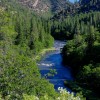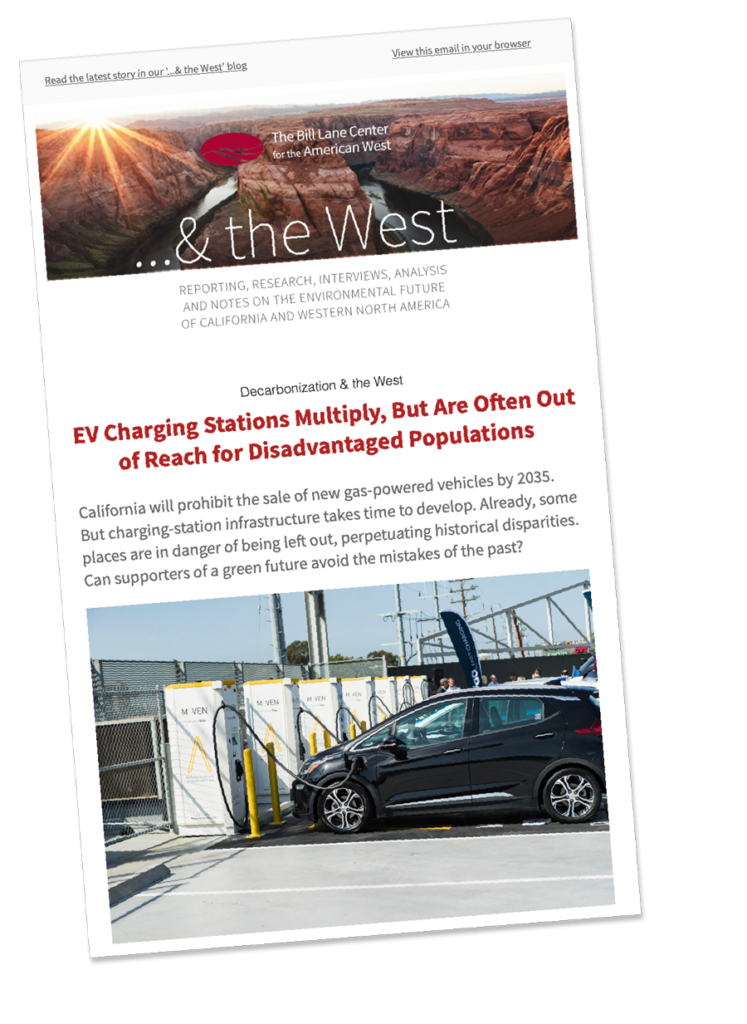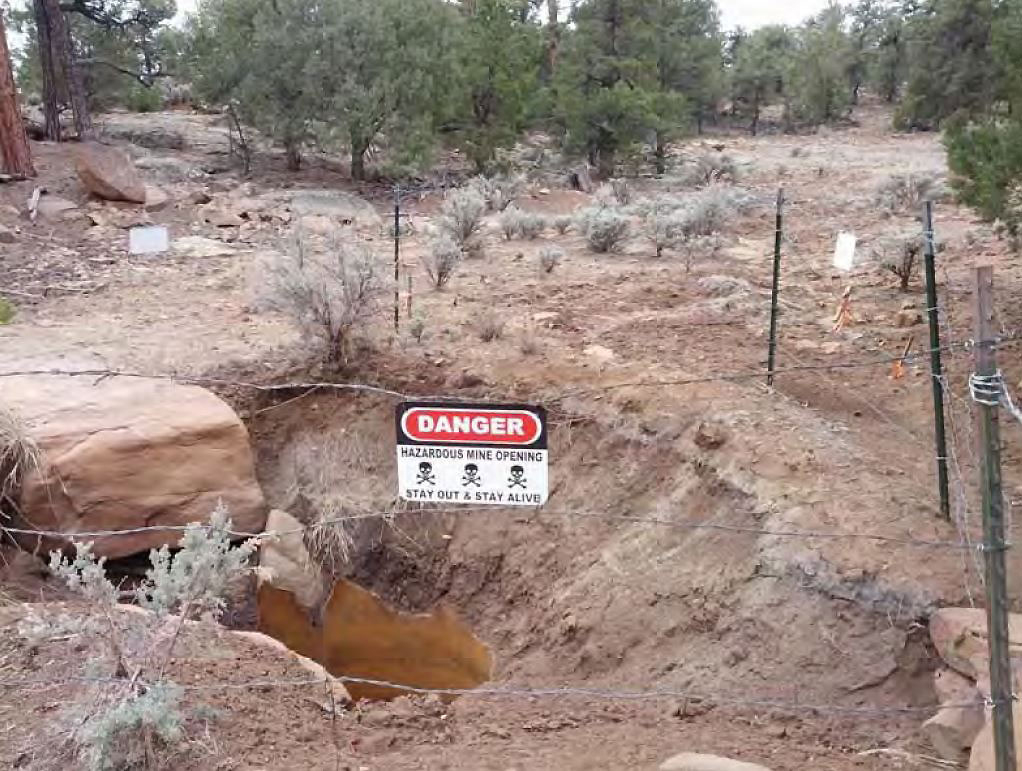
Unhealed wounds An open vent hole at the Ruby 1 mine site photographed in 2013. U.S. EPA Region 9
Fences surround some known abandoned uranium mines on Navajo Nation, but in 2017, when mine cleanup activist Klee Benally’s handheld Geiger counter maxed out in Cameron, Arizona — just a quarter mile from residences — the land he was on was unfenced and unmarked.
Benally and his team immediately notified authorities. Two years later, a fence was built around the area. Still, the fence doesn’t block wind-blown radioactive dust particles from getting into houses. Nor does it prevent rain from washing toxins into drinking water.

Sarana Riggs examines soil in Cameron with a geiger counter. Sandy Bahr, Sierra Club
The Cameron site is one of more than 500 abandoned uranium mine sites on Navajo Nation, a West Virginia-sized area spanning northern Arizona, southern Utah, and western New Mexico. Promises to clean them up have come and gone. Now the Environmental Protection Agency (EPA) has opened an office in Colorado with plans to expedite cleanup on Navajo land as part of its oversight of abandoned mines. But the agency’s cleanup record has many doubting that change will come.
The new Office of Mountains, Deserts and Plains will oversee the cleanup of thousands of hard-rock mining sites west of the Mississippi River, including the abandoned uranium mines on Navajo Nation. Most local authorities, private experts and activists agree that since 1994, when the EPA started to address the mines, cleanup efforts of uranium mining sites have been slow. And that has had potentially deadly consequences: known effects of uranium exposure include compromised immune function and various forms of cancer.
EPA administrator Andrew Wheeler has pitched the new office as an answer to a “one-size-fits-all” approach to environmental remediation. “Creating a western lands-focused office will not only give EPA the ability to prioritize and accelerate cleanup of mining sites in the West,” he wrote in a guest column for the Colorado Springs Gazette, “it will also act as a model for other regions across America needing to address their own unique environmental challenges.”
The early September announcement of the office’s opening comes as the Trump administration proposes to promote uranium mining to improve what it calls the country’s “competitive nuclear advantage.” The administration unveiled a plan in late April to relax barriers to uranium mining on federal lands and develop a $150 million uranium reserve over the next decade.
Bill Lane Center for the American West
The EPA’s renewed interest in uranium cleanup marks a second time in the past two decades that the issue has seen federal attention. The U.S. House of Representatives in 2007 directed the EPA and other agencies to address uranium contamination, in the wake of a series of articles in the Los Angeles Times detailing the health consequences of the abandoned mines. The agencies were required to conduct five-year reviews to assess clean-up needs and reach settlements with responsible parties.
No mines have been cleaned up to date, although the EPA has taken measures to improve safety around high-priority abandoned mines.
“Even just having a good handle on what exactly is out there has taken a pretty long time, and I’m not convinced that that even is the case yet,” said Sierra Club Grand Canyon Chapter Director Sandy Bahr.
Cold War Uranium Rush Gives Way to Superfund and Cleanup Efforts

Soil sampling to determine extent of contamination at an abandoned uranium mine. Environmental Protection Agency
The federal government’s renewed interest in uranium cleanup, which goes hand in hand with its renewal of extraction efforts, rekindles memories of a painful historical legacy for the Navajo Nation. During the Cold-War rush to mass-produce fuel for nuclear weapons, mining companies extracted nearly 30 million tons of uranium ore from Navajo land.
The Department of Energy had a “no questions asked” policy for sources of uranium, jumpstarting a massive amount of mining in the Southwest, said Benally, who identifies as Diné, the name for the Navajo people. At the time of mining there was no legal requirement for companies to do cleanup.
As the demand for uranium slowed as the Cold War ended, companies abandoned the mines and went out of business. “They would take their profits and leave the damage that was done,” Benally said. He added that between 70 and 80 percent of these abandoned mines are located on tribal and public lands, and the EPA has identified 523 abandoned mines on Navajo land.
“The uranium industry has gotten a free pass on public lands, and the government agencies have just looked the other way. Our communities have been sacrificed; it’s an extreme form of environmental racism,” he said.
The decades after the uranium rush on western lands saw an environmental awakening in the United States characterized by the passage of laws like 1980’s Comprehensive Environmental Response, Compensation, and Liability Act (CERCLA) — otherwise known as Superfund.
Superfund was enacted to allow the federal government to better ensure the cleanup of contaminated sites, after activists were galvanized by environmental disasters like the hazardous waste dumping at Love Canal and the buildup of toxic waste at the Valley of the Drums. Among other provisions, the legislation allows the government to address contaminated sites and obtain the money necessary to fund the cleanups.

A sign warns against radiation in Cameron, AZ. Sandy Bahr, Sierra Club
But abandoned mining sites pose a unique challenge: Many of the mines have been abandoned for decades, the responsible parties no longer exist and the scope of the problem — along with the amount of money necessary to clean up the sites — is enormous. “Cleanup only goes as fast as you have money,” said Oliver Whaley, the executive director of Navajo Nation’s Environmental Protection Agency (NNEPA). “And there hasn’t been much cleanup.”
Initial settlement funds are being used to assess contamination at the abandoned sites, according to Dariel Yazzie, who heads the Navajo Nation Superfund Program for NNEPA. In the meantime, the EPA has taken time-sensitive actions like putting up fences around contaminated areas — like the fence in Cameron — and consolidating waste at about 30 sites.
The EPA will submit a 10-year plan to the federal Office of Management and Budget this fall, with a schedule for addressing the approximately 200 mines eligible for Superfund funding for assessment and cleanup. And the Office of Mountains, Deserts and Plains “will initiate discussion with the Navajo Nation to identify their concerns and issues with the pace of cleanup,” the EPA wrote in a statement to “…& the West.”
The EPA has $1.7 billion available to begin assessment and cleanup at 219 of the mines after reaching Superfund settlements with former companies involved in mining. These funds include: $950 million from the 2015 bankruptcy settlement of Tronox Incorporated, covering mines operated by the Kerr-McGee Corp.; $335 million from an administrative settlement with Cypress Amax; and up to $5 million a year from the EPA’s own budget. In 2008, the search began for parties responsible for the Navajo Nation mines; the most recent settlement agreement was reached in 2016, bringing in an additional $22 million. Whaley anticipates it would take another $3 billion to $4 billion to clean up all the mines. [Correction appended]
One Nation, 500 Uranium Mines
The Navajo Nation, population 173,000, covers an area nearly twice the size of Switzerland in the Four Corners region of the Southwest. Across its breadth, from Cameron, Arizona in the West to outside of Albuquerque, N.M., Navajo land is studded with the toxic remnants of the Cold War: about 500 abandoned uranium mine sites.
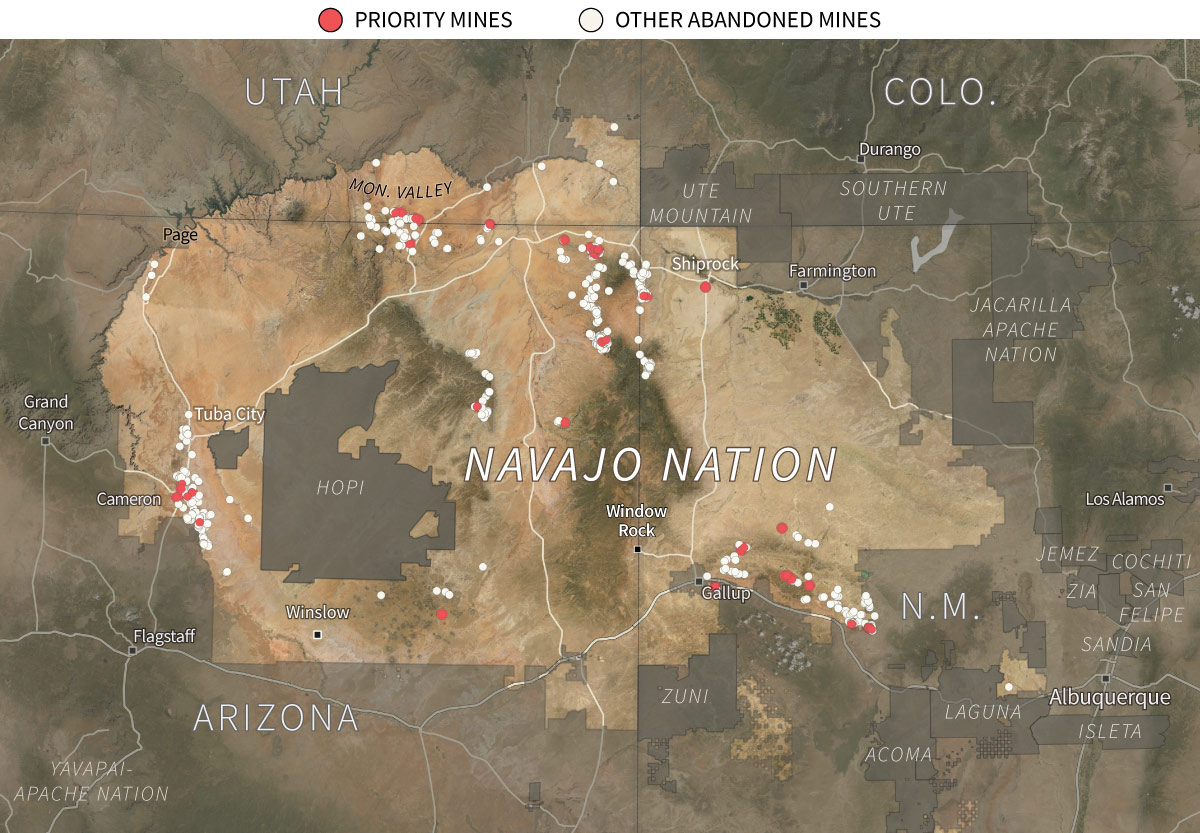
Sources: Environmental Protection Agency (mine sites); Census Bureau (Native Nation boundaries); Natural Earth Data; ESRI World Imagery;
Geoff McGhee/Bill Lane Center for the American West
The Navajo Nation is also pursuing funding through Congress and is considering legal action against the EPA to force it to track down the remaining funds, according to Whaley, but there is no easy way to collect the rest of the money.
At one meeting between Navajo Nation residents and the EPA, Benally recalled a former uranium miner asking EPA representatives what he ought to do with remaining pulverized rock debris from the mines, also known as tailings. “Should I just start bringing five gallon buckets of rocks that I know are radioactive and just dump them here for you to take away?” Benally recalled the miner asking. “Should I just start selling them on eBay?”

Protesters at a July 2010 legislative hearing in New Mexico. Chris Shuey, Southwest Research and Information Center
Dark humor aside, there is no easy or simple way to clean up the sites; approaches to cleanup and land reclamation vary by site. Some sites are dotted by abandoned mining infrastructure, including buildings and chutes to nowhere. At others, mounds of debris dot the land, with visible markings on the ground from water runoff.
According to International Atomic Agency guidelines, typical cleanup efforts include removing abandoned structures and controlling radon and radioactive dust emissions. Tailings are moved to an impoundment facility, homes built nearby with tailings are rebuilt and water sources are protected from further contamination. The government’s cleanup assessment of sites is taking longer than planned; at the current pace, complete cleanup could take a century, said Chris Shuey, who has documented the impacts of uranium on Navajo Nation through the Southwest Research and Information Center since the 1980s.
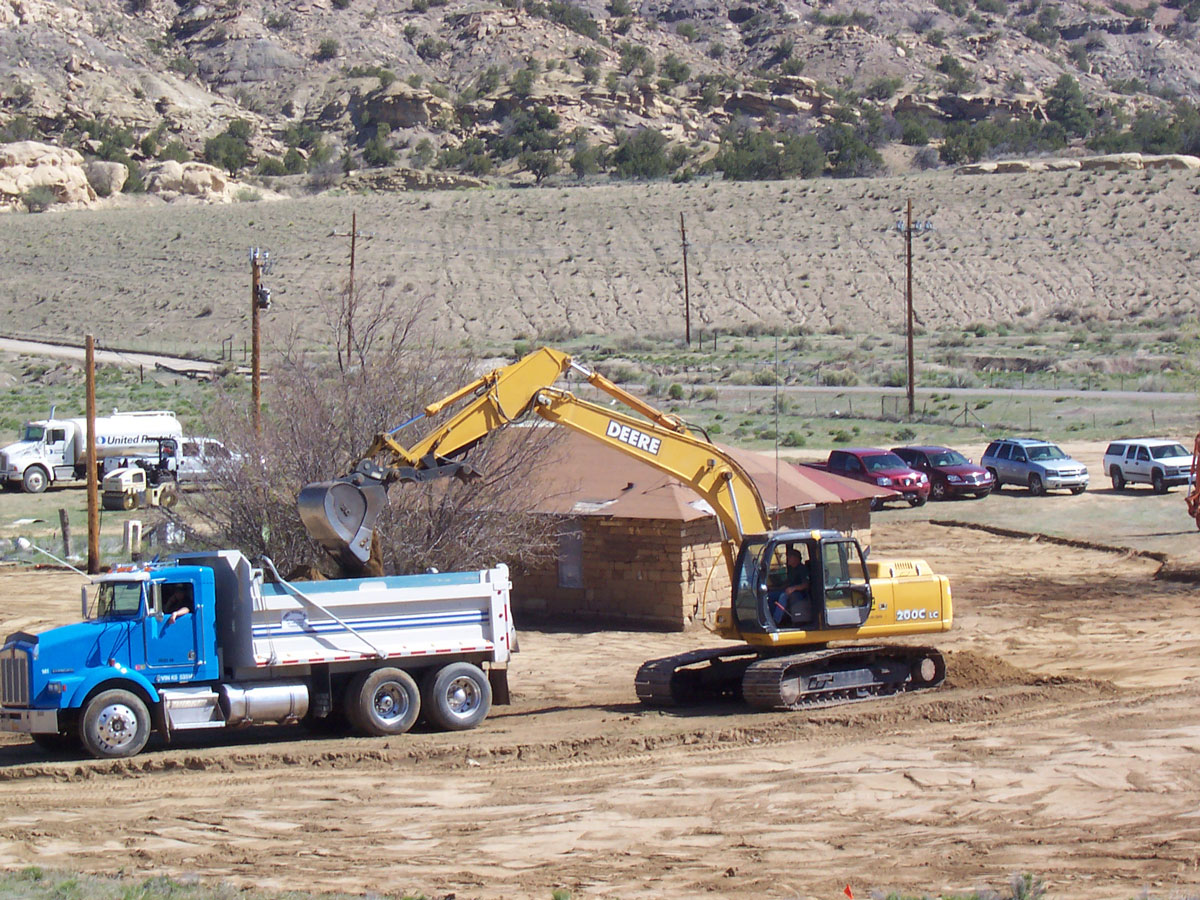
Crews excavate uranium- and radium-contaminated soils from around a traditional Navajo home (called a hogan) in the Red Water Pond Road Community on the Navajo Nation. Chris Shuey, Southwest Research and Information Center
Regardless of the extent of cleanup efforts and their long-term effectiveness, the new attention they have received has galvanized some tribal members to focus on restoration and healing.
“We have a lot of collaborative work to do to advance knowledge about viable clean-up, and it likely will not be done in my lifetime,” said Cherie DeVore, a Diné postdoctoral research fellow in earth system science at Stanford, who has studied the consequences of uranium contamination. “We have to think of the focus on cleanup as the beginning of a very long marathon, together.”
Poisoned Water, Poisoned Homes

Christopher Nez, a Navajo Nation resident and son of a former uranium miner, inspects a large boulder originating from an abandoned mine, Claim 28. Radiation surveys on the rock revealed gamma radiation rates between 500 and 1,000 times greater than normal levels in the area, confirming that the rock contains high-grade uranium ore. A plan to remove or remediate mine wastes at the site has not been proposed as of October 2020. Chris Shuey, Southwest Research and Information Center
Cleanup or no, the nuclear legacy is already firmly established in the Navajo Nation, with uranium-tainted dust having spread widely across the landscape. But accurately determining the breadth of exposure to the nation’s 173,000 residents and its health implications remains challenging.
High levels of uranium in the body or exposure to radiation can have serious health effects. Navajo Nation residents can come in contact with uranium through proximity to the abandoned mines, living in a home built with material from the abandoned mines and drinking contaminated water.
Researchers like a University of New Mexico team led by toxicologist Johnnye Lewis have found links between uranium exposure and such conditions as hypertension, kidney disease and a combination of metabolic diseases, along with biological markers of immune impairment among Navajo people living near abandoned mines. [Correction appended]
Fourteen percent of the participants in one of Shuey’s studies, which was open to anyone on Navajo Nation, reported living within about three miles of an abandoned mine.

Nearly 200 feet of uranium mine wastes cover the slope of a mesa overlooking a Navajo homestead in Blue Gap-Tachee Chapter of the Navajo Nation in northeastern Arizona in June 2014. The homes shown are within one third of a mile of the Claim 28 Mine. Chris Shuey, Southwest Research and Information Center
But while the general health consequences of uranium exposure are well documented, few studies directly trace exposure from Navajo Nation’s abandoned mines to health impacts on individuals living nearby. Loretta Christensen, the Indian Health Service’s chief medical officer for the Navajo area, said that she was fairly confident many significant medical illnesses in mine workers or their family members could be attributed to uranium. For those with a less direct link to the mines, the connection was less clear.
The traditionally semi-nomadic nature of the Navajo people and movement of people in and out of the Navajo Nation area further complicates efforts to pinpoint possible exposure and impacts, though advanced epidemiology is making those efforts easier, according to Christensen, who is Diné.
Sarana Riggs, who is Diné and helped organize efforts to teach people living in Navajo Nation to use Geiger counters, said that as a child, she never understood that she was growing up near abandoned uranium sites. Now, she said she realizes that the abandoned mines have an impact on Navajo life on many levels. Contaminants have seeped into water sources that generations of Navajo have used, Riggs said. It has potentially contaminated the livestock that the Navajo raise and eat or the crops they grow.
“We survived a long walk, which was an extermination tactic,” she said. “We didn’t survive that just to keep fighting against corporations and policy.”
New Office Met With Mixed Reactions

Abandoned uranium mines in the Cove area of Navajo Nation. Environmental Protection Agency
After his first call with administrators from the new EPA office, Whaley, the Navajo EPA director, expressed hope that it could help expedite cleanup. The new office could help Navajo Nation directly communicate its interest in how cleanup will take place, Whaley said.
Whaley believes that it is essential to have community buy-in on cleanup projects, and that Navajo workers help in the process. “One part of healing is actually cleaning up the waste that’s been left behind. But the other part is doing it in a manner that people can feel good with the end result,” he said.
That call in mid-September was the only call NNEPA has had with staff at the new office as of Thursday, said Yazzie.
Other activists worry the new office could make it easier for mining groups to lobby the EPA or promote further mining. Bahr fears that “industry folks,” like uranium mining company representatives, would have more access to lobby the EPA. “If you go into the Department of Environmental Quality and look at the sign-in sheet, you would see almost all industry people having signed in,” she added.
Some worry that a federal “Good Samaritan” program could make clean-up efforts a cover for new mining. Part of the Superfund law encourages volunteers to clean up abandoned mines in return for the EPA limiting or waiving liability under the Clean Water Act and Superfund laws.
Aaron Mintzes, a senior policy counsel at the environmental nonprofit Earthworks, calls some Good Samaritan projects “good sham permits,” and worried that the office would further enable mining instead of cleanup. “It’s not feasible that they want the nine staff cleaning up the estimated 500,000 abandoned hard-rock mines,” Mintzes said. “It’s more feasible that they have the nine staff to help dish out Good Samaritan permits to mining companies.”
Mintzes cited the case of the Nez Perce and Midas Gold Corp. Midas Gold took over one of its abandoned mines on Nez Perce land in 2009, pledging to remediate the area as it re-mines the area. The Nez Perce have since filed a Clean Water Act lawsuit against Midas Gold Corp. Midas Gold is now in the process of receiving a Good Samaritan waiver for its work. Midas Gold did not respond to a request for comment.
The EPA said it has entered into eight Good Samaritan agreements with parties — typically conservation groups — who do not mine or own a mining site. The Office of Mountains, Deserts, and Plains, the agency said, intends to work with conservation groups and other interested parties to encourage them to take on these kinds of improvement projects.
Whaley strongly pushed back on the idea that the new office could mean the Navajo Nation would see more mining.“As long as we’re here, we will fight for our Navajo people,” he said. “If we ever had even an inclination that [new mining] was being discussed, we’ll pull out all the stops. It won’t happen.”
Benally said he, too, was “cautiously optimistic” about the potential impact of the new office, adding that the location would allow advocates to put more pressure on the EPA while bringing the agency closer to where the abandoned mines’ impacts is felt.
“We take what we can get, and we get our wins when we can and where we can,” Whaley said.

Cleanup advocates and environmentalists — including Bahr, Riggs and Arizona State Senator Jamescita Peshlakai — stand near a radiation warning sign in Cameron. Sandy Bahr, Sierra Club
DeVore said that Navajo origin narratives focus on slaying monsters. Two of the important figures in the narrative are twins: the Monster Slayer, responsible for addressing destruction, and the Child Born of Water, responsible for repair.
DeVore sees the abandoned mines as a monster. She feels the narrative surrounding mining has been one of despair, loss and grief. But young people and activists in her community are shifting the focus from addressing destruction to one of restoration.
“Number one, we have to slay the monster,” DeVore added. “But after that, we need to do the restorative work — the really restorative work — to rebalance ourselves and heal our communities.”
Correction
An earlier version of this post referred incompletely to the sources of funds for remediation. The EPA’s roughly $1.7 billion for 219 of 523 abandoned mines includes $950 million from the 2015 Tronox bankruptcy, covering mines operated by Kerr-McGee Corp., $335 million from an administrative settlement with Cypress Amax, and about $22 million from federal settlements with the Navajo Nation for orphan sites. The EPA has pledged up to $5 million a year from its own budget.
The post also imprecisely described research findings on the health impacts of uranium exposure. Research by a University of New Mexico team headed by toxicologist Johnnye Lewis found significant increased risks of hypertension, kidney disease and a combination of metabolic diseases along with biological markers of immune impairment among Navajo people living near abandoned mines.
Contact Kate Selig at kkselig23 ‘at’ stanford.edu.
Edited by Felicity Barringer and Geoff McGhee.
Read Next in …& the West
The Winners, the Losers, and the Landscape That Might Emerge If the Klamath River Dams Disappear
Two decades into the 21st Century, broadband internet access still falls short of reaching tens of millions of Americans – especially in hilly and remote parts of the rural West. But local initiatives and creative uses of technology are slowly helping close the divide.
Reader Comments
Submit your own thoughts and questions by using the form at the bottom of this page. Entries will be reviewed and posted as we get them.
